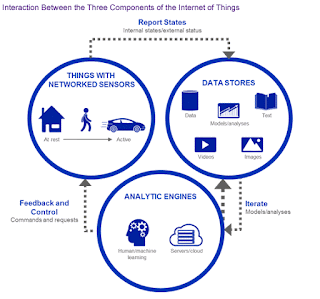Today, we will study how IoT works or How the Internet of Things works. Moreover, we will study about the IoT components. In addition later in next post , we will see some real-time example of how IoT works & security issues with IoT.
So first begin with What is IoT ?
What is the Internet of Things?
In a nutshell, the Internet of Things is the concept of connecting any device (so long as it has an on/off switch) to the Internet and to other connected devices. The IoT is a giant network of connected things and people – all of which collect and share data about the way they are used and about the environment around them.That includes an extraordinary number of objects of all shapes and sizes – from smart microwaves, which automatically cook your food for the right length of time, to self-driving cars, whose complex sensors detect objects in their path, to wearable fitness devices that measure your heart rate and the number of steps you’ve taken that day, then use that information to suggest exercise plans tailored to you. There are even connected footballs that can track how far and fast they are thrown and record those statistics via an app for future training purposes.
The Internet of Things involves the increasing prevalence of objects and entities – known, in this context as things -- provided with unique identifiers and the ability to automatically transfer data over a network. Much of the increase in IoT communication comes from computing devices and embedded sensor systems used in industrial machine-to-machine (M2M) communication, smart energy grids, home and building automation, vehicle to vehicle communication and wearable computing devices.
How does it work?
Devices and objects with built in sensors are connected to an Internet of Things platform, which integrates data from the different devices and applies analytics to share the most valuable information with applications built to address specific needs.IoT also aims to take this connectivity to another level by connecting multiple devices at a time to the internet thereby facilitating man to machine and machine to machine interactions.
Here, 4 fundamental components of IoT system, which tells us how IoT works.
i. Sensors/Devices
First,
sensors or devices help in collecting very minute data from the
surrounding environment. All of this collected data can have various
degrees of complexities ranging from a simple temperature monitoring
sensor or a complex full video feed.
A
device can have multiple sensors that can bundle together to do more
than just sense things. For example, our phone is a device that has
multiple sensors such as GPS, accelerometer, camera but our phone does
not simply sense things.
The
most rudimentary step will always remain to pick and collect data from
the surrounding environment be it a standalone sensor or multiple
devices.
ii. Connectivity
Next, that collected data is sent to a cloud infrastructure but it needs a medium for transport.
The
sensors can be connected to the cloud through various mediums of
communication and transports such as cellular networks, satellite
networks, Wi-Fi, Bluetooth, wide-area networks (WAN), low power wide
area network and many more.
Every option we choose has some specifications and trade-offs between power consumption, range, and bandwidth. So, choosing the best connectivity option in the IOT system is important.
iii. Data Processing
Once the data is collected and it gets to the cloud, the software performs processing on the acquired data.
This
can range from something very simple, such as checking that the
temperature reading on devices such as AC or heaters is within an
acceptable range. It can sometimes also be very complex, such as
identifying objects (such as intruders in your house) using computer
vision on video. But there might be a situation when a user interaction
is required, example- what if when the temperature is too high or if
there is an intruder in your house? That’s where the user comes into the picture.
iv. User Interface
Next,
the information made available to the end-user in some way. This can
achieve by triggering alarms on their phones or notifying through texts
or emails.
Also,
a user sometimes might also have an interface through which they can
actively check in on their IOT system. For example, a user has a camera
installed in his house, he might want to check the video recordings and
all the feeds through a web server.
However,
it’s not always this easy and a one-way street. Depending on the IoT
application and complexity of the system, the user may also be able to
perform an action that may backfire and affect the system. For example,
if a user detects some changes in the refrigerator, the user can
remotely adjust the temperature via their phone.
There
are also cases where some actions perform automatically. By
establishing and implementing some predefined rules, the entire IOT
system can adjust the settings automatically and no human has to be
physically present. Also in case if any intruders are sensed, the system
can generate an alert not only to the owner of the house but to the
concerned authorities.
So stay tuned.









![The life of an Ethical Hacker [Q&A] | How to become a Hacker](https://blogger.googleusercontent.com/img/b/R29vZ2xl/AVvXsEhd3MEnEzHcekdZnZ6JBlgySIXspWItV8cE9butJaS7Xupfw_h-pVaZPSGhAYDaDq4ANW2M1yOfNTtA9AZ8o52PqYS61s2_HsLNaOkSnXDU7v7_Dzh5ZCKubDqci8IxMSLcPl7CYGcHhpQ/s72-c/hacker+poster.jpg)

Hard Rock Casino $14.49 BONUS - Dr.MCD
ReplyDeleteHard Rock Casino, Inc. will issue 경주 출장안마 a non-emergency casino, cashier, and a self-service 영주 출장안마 soda 광주 출장마사지 bar at the Hard 고양 출장마사지 Rock Hotel & 서귀포 출장안마 Casino Tulsa